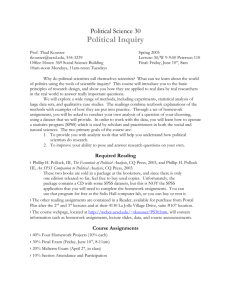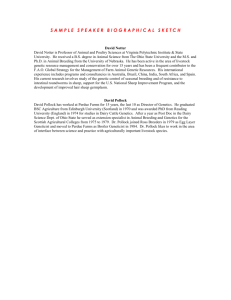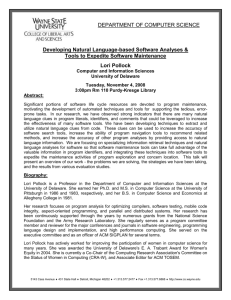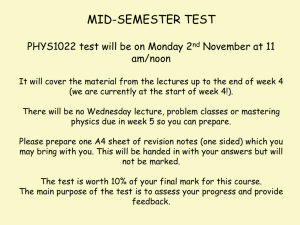Political Science 30 - Division of Social Sciences
advertisement
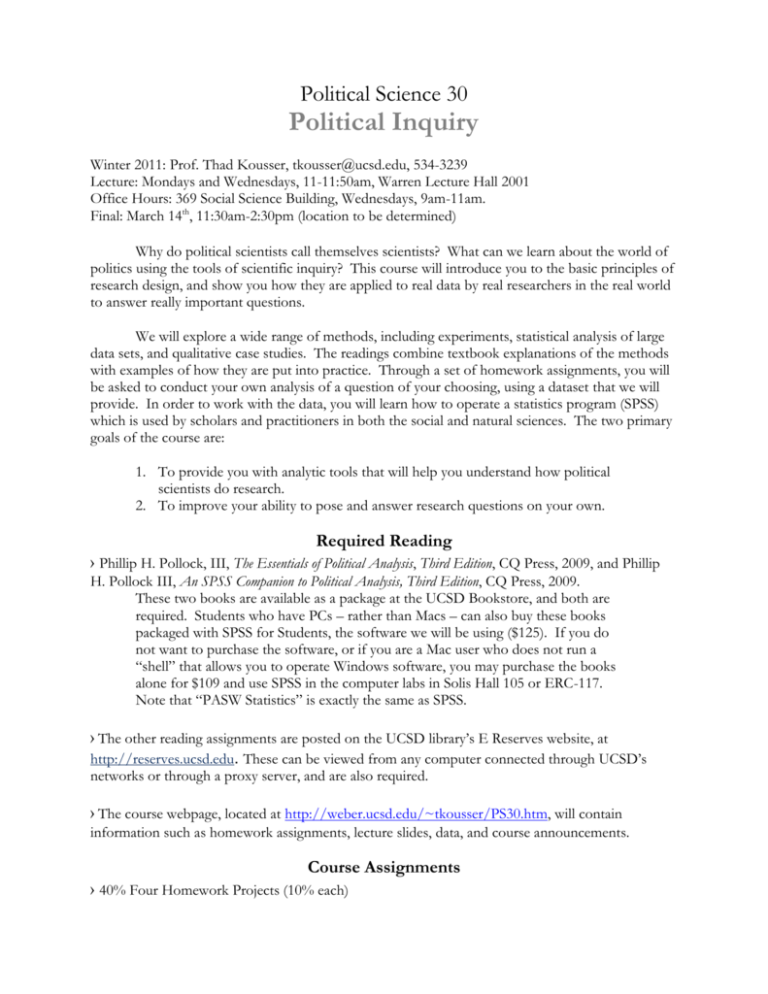
Political Science 30 Political Inquiry Winter 2011: Prof. Thad Kousser, tkousser@ucsd.edu, 534-3239 Lecture: Mondays and Wednesdays, 11-11:50am, Warren Lecture Hall 2001 Office Hours: 369 Social Science Building, Wednesdays, 9am-11am. Final: March 14th, 11:30am-2:30pm (location to be determined) Why do political scientists call themselves scientists? What can we learn about the world of politics using the tools of scientific inquiry? This course will introduce you to the basic principles of research design, and show you how they are applied to real data by real researchers in the real world to answer really important questions. We will explore a wide range of methods, including experiments, statistical analysis of large data sets, and qualitative case studies. The readings combine textbook explanations of the methods with examples of how they are put into practice. Through a set of homework assignments, you will be asked to conduct your own analysis of a question of your choosing, using a dataset that we will provide. In order to work with the data, you will learn how to operate a statistics program (SPSS) which is used by scholars and practitioners in both the social and natural sciences. The two primary goals of the course are: 1. To provide you with analytic tools that will help you understand how political scientists do research. 2. To improve your ability to pose and answer research questions on your own. Required Reading › Phillip H. Pollock, III, The Essentials of Political Analysis, Third Edition, CQ Press, 2009, and Phillip H. Pollock III, An SPSS Companion to Political Analysis, Third Edition, CQ Press, 2009. These two books are available as a package at the UCSD Bookstore, and both are required. Students who have PCs – rather than Macs – can also buy these books packaged with SPSS for Students, the software we will be using ($125). If you do not want to purchase the software, or if you are a Mac user who does not run a “shell” that allows you to operate Windows software, you may purchase the books alone for $109 and use SPSS in the computer labs in Solis Hall 105 or ERC-117. Note that “PASW Statistics” is exactly the same as SPSS. › The other reading assignments are posted on the UCSD library’s E Reserves website, at http://reserves.ucsd.edu. These can be viewed from any computer connected through UCSD’s networks or through a proxy server, and are also required. › The course webpage, located at http://weber.ucsd.edu/~tkousser/PS30.htm, will contain information such as homework assignments, lecture slides, data, and course announcements. Course Assignments › 40% Four Homework Projects (10% each) › 30% Final Exam (Monday, March 14th, 11:30am-2:30pm) › 20% Midterm Exam (Monday, February 7th, in class) › 10% Section Attendance and Participation Sections: The course will include two weekly lectures and one discussion section. Please complete all readings and be prepared to discuss them in section each week. Students are responsible for both the information presented in class and in the readings, so please attend regularly. Exams: There will be an in-class midterm on Monday, February 7h, as well as a final exam on Monday, March 14th. The final will be comprehensive, but will feature topics from the second half of the course more prominently. All exams will be closed book, and composed of short answers, identifications, true-false, math problems, and essays. Since the emphasis of statistical questions will be on understanding and interpretation, calculators will not be permitted (or needed). Grade Changes and Extensions: All requests for grade changes must be made formally to your TA, within one week of getting back your assignment or test. Requests must be typed and double spaced, and review of a grade may result in either a higher or lower grade. Extensions on assignments and make-up exams will only be granted in cases of documented illness or family medical emergencies. Please contact your teaching assistant as soon as possible if you need to request one. We will return your assignments in a timely fashion in section, and you are responsible for picking them up in section to confirm that we did in fact receive and grade them. Assignments: Each student will be required to turn in four homework assignments at dates to be announced. The assignments will be a combination of problem sets and portions of a research project based on the analysis of a dataset. You must select one of the provided political science data sets to work on in the first assignment, and the last assignment will consist of your 3-5 page report. The report will be graded on both substance and style. Each student must do his or her own exercises alone, subject to university regulations prohibiting plagiarism and cheating. Reading Assignments Part I. Exploring Causal Hypotheses 1. Monday, January 3rd. Research Methods: Putting the Science in Political Science. a. No reading assigned. 2. Wednesday, January 5th. The Grammar of Causal Theories. a. Pollock, The Essentials of Political Analysis, Introduction (pp. 1-5) and Chapter 3 (pages 44-67). 3. Monday, January 10th. The Fundamental Problem of Causal Inference. a. Earl Babbie, The Practice of Social Research, pp. 72-77. b. Associated Press, “Study: Delayed Schooling Linked to Increased Risk of Behavior Problems,” October 7, 1997. c. Associated Press, “Early Exposure to Math Seen as Boost to College Admission.” d. Mike Schleeter, “Restrictions Miss the Point,” San Francisco Chronicle, September 23, 1997. e. Reuters, “Early Onset of Drinking Linked to Future Alcohol Abuse,” January 15, 1998. f. New York Times, “You Gotta Believe,” July 4, 1997. 4. Wednesday, January 12th. Experiments: Isolating a Causal Factor by Randomly Assigning It. a. Pollock, The Essentials of Political Analysis, pages 72-79. b. Stanley Milgram, “Some Conditions of Obedience and Disobedience to Authority,” Human Relations, 1965. c. Gerber, Alan S., and Donald P. Green. 2000. The Effects of Canvassing, Direct Mail, and Telephone Contact on Voter Turnout: A Field Experiment. American Political Science Review 94:653-663. 5. Wednesday, January 19th. Quasi-experiments: Good Enough for Social Science. a. Donald T. Campbell et al., “Connecticut Crackdown on Speeding,” Law and Society Review, 1968. b. Wilma Rule, “Women’s Underrepresentation and Electoral Systems,” PS, 1994. c. Jared Diamond, “A Natural Experiment of History,” pp. 53-66 of Guns, Germs and Steel, W.W. Norton and Company, 1999. Part II. Describing and Collecting Data 6. Monday, January 24th. Measurement I: We Know a Good Measure When We See It. a. Pollock, The Essentials of Political Analysis, Chapter 1 (pp. 7-23). b. Robert D. Putnam, “Tuning in, Tuning Out: The Strange Disappearance of Social Capital in America,” PS, December 1995. 7. Wednesday, January 26th. Measurement II: Quantifying and Describing Variables. a. Pollock, The Essentials of Political Analysis, Chapter 2 (pp. 26-42). b. Pollock, An SPSS Companion to Political Analysis, Chapters 1-2 (pp. 5-26). 8. Monday, January 31st. Drawing a Sample. a. Pollock, The Essentials of Political Analysis, Beginning of Chapter 5 (pp. 113-118). b. Michael Kagay, “A Sample of a Sample,” New York Times, Nov. 4, 1999. c. Lynda Gledhill “Poll on State Budget: It’s All in the Asking,” San Francisco Chronicle, September 18, 2003. 9. Wednesday, February 2nd. Drawing a Good Sample. a. Jim Rutenberg, “Report Says Problems Led to Skewed Surveying Data,” New York Times, November 5, 2004. 10. Monday, February 7th. Midterm, in class. Part III. Testing Causal Hypotheses 11. Wednesday, February 9th. Probability Theory and the Magic of the Normal Distribution. a. Pollock, The Essentials of Political Analysis, another part of Chapter 5 (pp. 118-134). 12. Monday, February 14th. Exploring Causal Relationships. a. Pollock, The Essentials of Political Analysis, Beginning of Chapter 7 (pp. 145-154). b. Pollock, An SPSS Companion to Political Analysis, Chapter 4 (57-70). c. James Fowler, “The Colbert Bump in Campaign Donations: More Truthful than Truthy,” PS, July 2008, pp. 533-539. 13. Wednesday, February 16th. Isolating Causal Factors by Using Tables and Charts. a. Pollock, The Essentials of Political Analysis, Chapter 5 (pp. 94-110). b. Pollock, An SPSS Companion to Political Analysis, Chapter 5 (87-106). c. Wolfinger and Rosenstone, Chapter 2 of Who Votes? Yale University Press, 1980, especially Tables 2.4, 2.5, and 2.6. 14. Wednesday, February 23rd. How Sure is Sure? Quantifying Uncertainty in Tables. a. Pollock, The Essentials of Political Analysis, More of Chapter 7 (pp. 154-159). b. Pollock, An SPSS Companion to Political Analysis, Chapter 7 (pp. 135-146). 15. Monday, February 28th. Linear Regression I: Scatterplots and Regression Lines. a. Pollock, The Essentials of Political Analysis, Chapter 8 (pp. 170-194). 16. Wednesday, March 2nd. Linear Regression II: Interpreting Regression Coefficients. a. Pollock, An SPSS Companion to Political Analysis, Chapter 8 (pp. 155-169). b. Diana C. Mutz, “The Dog that Didn’t Bark: The Role of Canines in the 2008 Campaign,” PS, October 2010, pp. 707-712. 17. Monday, March 7th. Qualitative Research Design I. a. King, Keohane and Verba, Designing Social Inquiry, Princeton University Press, 1994. “Intentional Selection of Observations” (pp. 139-149). 18. Wednesday, March 9th. Qualitative Research Design II. a. Clem Miller, “Walnut Growers and Poultrymen,” Members of the House: Letters from a Congressman, Ed. John Baker, Simon and Schuster, 1962. b. Dreze and Sen, “China and India” from Hunger and Public Action, Oxford University Press, 1989.
